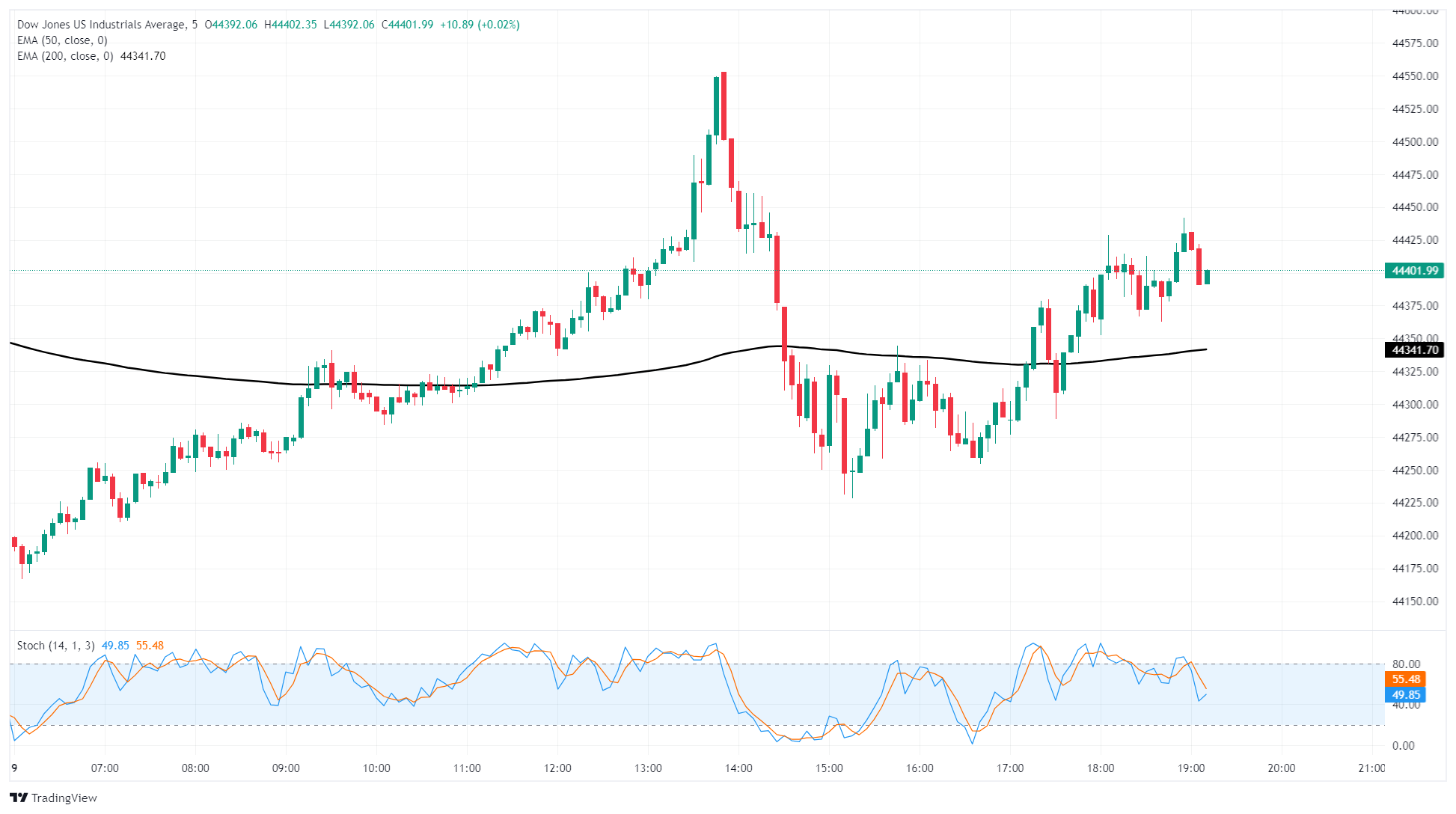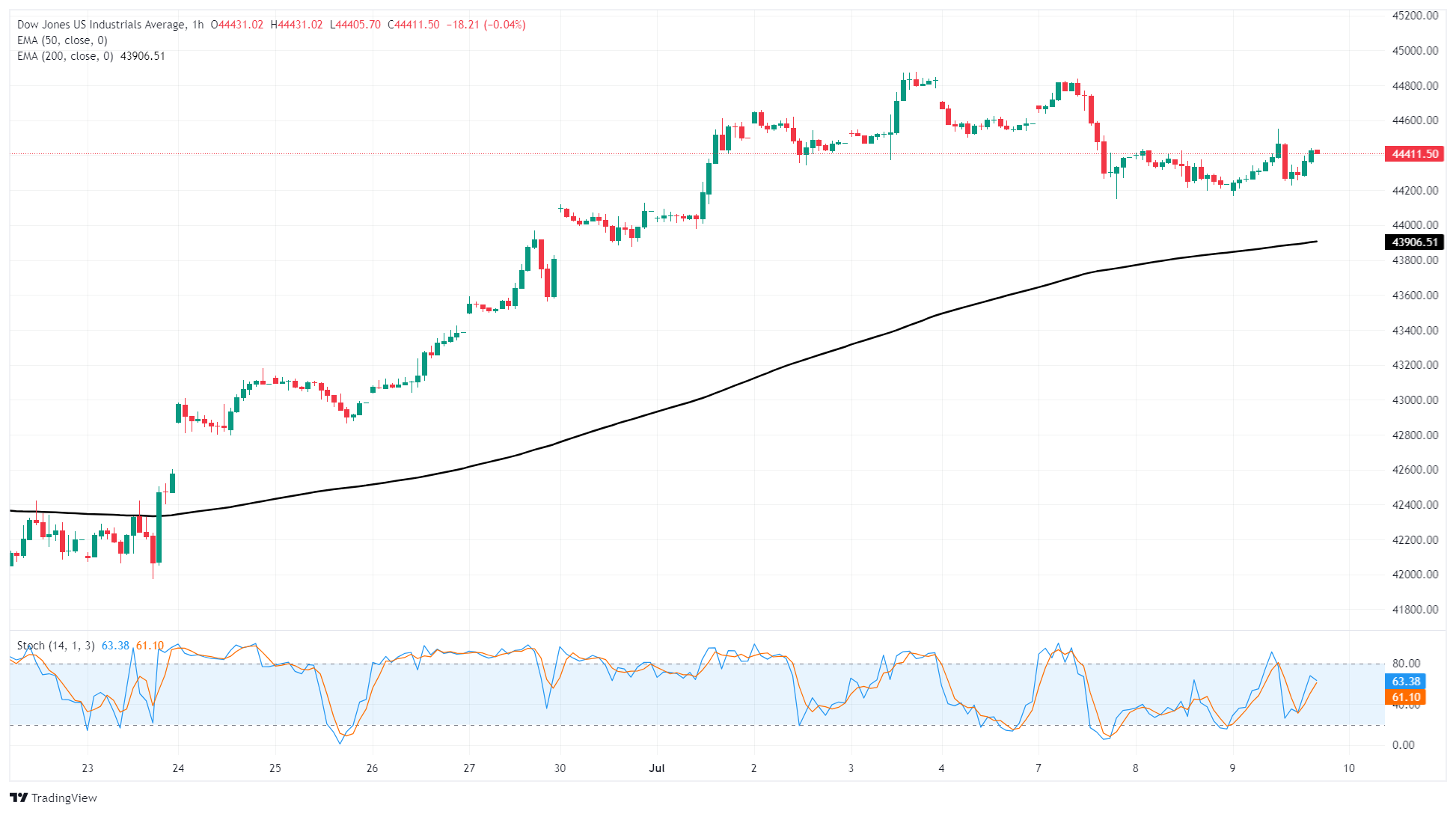Dow Jones Industrial Average tests higher amid choppy markets as tariff threats continue
- The Dow Jones found higher ground on Wednesday, but headline risks remain.
- The Trump administration is determined to appear tough on tariffs after another delay.
- The Fed’s latest Meeting Minutes showed a widening spread of internal rate cut expectations.
The Dow Jones Industrial Average (DJIA) gained some ground on Wednesday, paring away some of the week’s early losses, although equities remain down overall from Monday’s opening bids. The Trump administration has continued its step-up of firmer demands for trade deals from foreign countries, even as President Trump kicks the can down the road on his own self-imposed tariff deadlines. Elsewhere, Nvidia (NVDA) became the first company in history to reach a market cap of $4 trillion, while Amazon (AMZN) took a hit after Prime Day sales volume tumbled compared to the previous year.
Big tariffs coming, and this time we mean it
President Donald Trump announced another wave of double-digit tariff levels that will come into effect on August 1, alongside the “reciprocal” tariffs that were initially announced and immediately delayed in early April. The global tariff package was delayed until July 9 after Trump repeated his pattern of backing down from the majority of his own tariff threats, and the date has been pushed back to the beginning of August. The Trump administration is pushing hard for countries to come to the negotiating table and deliver trade deals that Trump finds acceptable, but progress has been slow. Despite Trump staffers teasing imminent trade deals like clockwork, very little progress on securing finalized trade terms has been made.
The Federal Reserve’s (Fed) latest Meeting Minutes showed the Fed remains buried deep in a wait-and-see stance, with central bank policymakers remaining apprehensive about the US’s economic outlook. According to the Fed’s internal rate discussions, headline inflation risks and job market downside factors have both diminished, but the latest rate meeting was held prior to this week’s batch of renewed tariff threats. The spread between individual policymakers on when to cut interest rates again has also widened, with several voting members of the Federal Open Market Committee (FOMC) disagreeing on whether a first rate cut should come in July, or get pushed out to sometime in 2026.
In a gold rush, sell shovels
Nvidia hit a $4 trillion market capitalization on Wednesday, taking the top spot as the first company in history to cross the valuation threshold. Nvidia has soared over several quarters, bolstered by the ongoing AI tech craze that has soon a metric ton of private equity capital pour into both shovel-seller Nvidia and gold-seeking AI startups looking to build first and ask revenue questions later. Elsewhere, solid-state EV battery maker QuantumScape (QS) is marching higher as the battery tech company achieves milestones on developing new power storage production methods.
Dow Jones price forecast
Wednesday was a choppy affair for the Dow Jones. Ongoing tech rallies and recovering investor sentiment briefly bolstered the major equity index into intraday highs near 44,560 before fresh tariff threats sent the Dow Jones into lows near 44,240. Despite intraday volatility, the Dow is trading on the high end of the day’s opening bids near 44,200.
The Dow Jones is still on the low side of the week’s price action, skidding along a fresh technical floor near 44,250. The Dow is still on the north side of the 200-hour Exponential Moving Average (EMA) near the 44,000 handle, but near-term declines could accelerate if bullish momentum takes too long of a breather.
Dow Jones 5-minute chart

Dow Jones 1-hour chart

Dow Jones FAQs
The Dow Jones Industrial Average, one of the oldest stock market indices in the world, is compiled of the 30 most traded stocks in the US. The index is price-weighted rather than weighted by capitalization. It is calculated by summing the prices of the constituent stocks and dividing them by a factor, currently 0.152. The index was founded by Charles Dow, who also founded the Wall Street Journal. In later years it has been criticized for not being broadly representative enough because it only tracks 30 conglomerates, unlike broader indices such as the S&P 500.
Many different factors drive the Dow Jones Industrial Average (DJIA). The aggregate performance of the component companies revealed in quarterly company earnings reports is the main one. US and global macroeconomic data also contributes as it impacts on investor sentiment. The level of interest rates, set by the Federal Reserve (Fed), also influences the DJIA as it affects the cost of credit, on which many corporations are heavily reliant. Therefore, inflation can be a major driver as well as other metrics which impact the Fed decisions.
Dow Theory is a method for identifying the primary trend of the stock market developed by Charles Dow. A key step is to compare the direction of the Dow Jones Industrial Average (DJIA) and the Dow Jones Transportation Average (DJTA) and only follow trends where both are moving in the same direction. Volume is a confirmatory criteria. The theory uses elements of peak and trough analysis. Dow’s theory posits three trend phases: accumulation, when smart money starts buying or selling; public participation, when the wider public joins in; and distribution, when the smart money exits.
There are a number of ways to trade the DJIA. One is to use ETFs which allow investors to trade the DJIA as a single security, rather than having to buy shares in all 30 constituent companies. A leading example is the SPDR Dow Jones Industrial Average ETF (DIA). DJIA futures contracts enable traders to speculate on the future value of the index and Options provide the right, but not the obligation, to buy or sell the index at a predetermined price in the future. Mutual funds enable investors to buy a share of a diversified portfolio of DJIA stocks thus providing exposure to the overall index.

